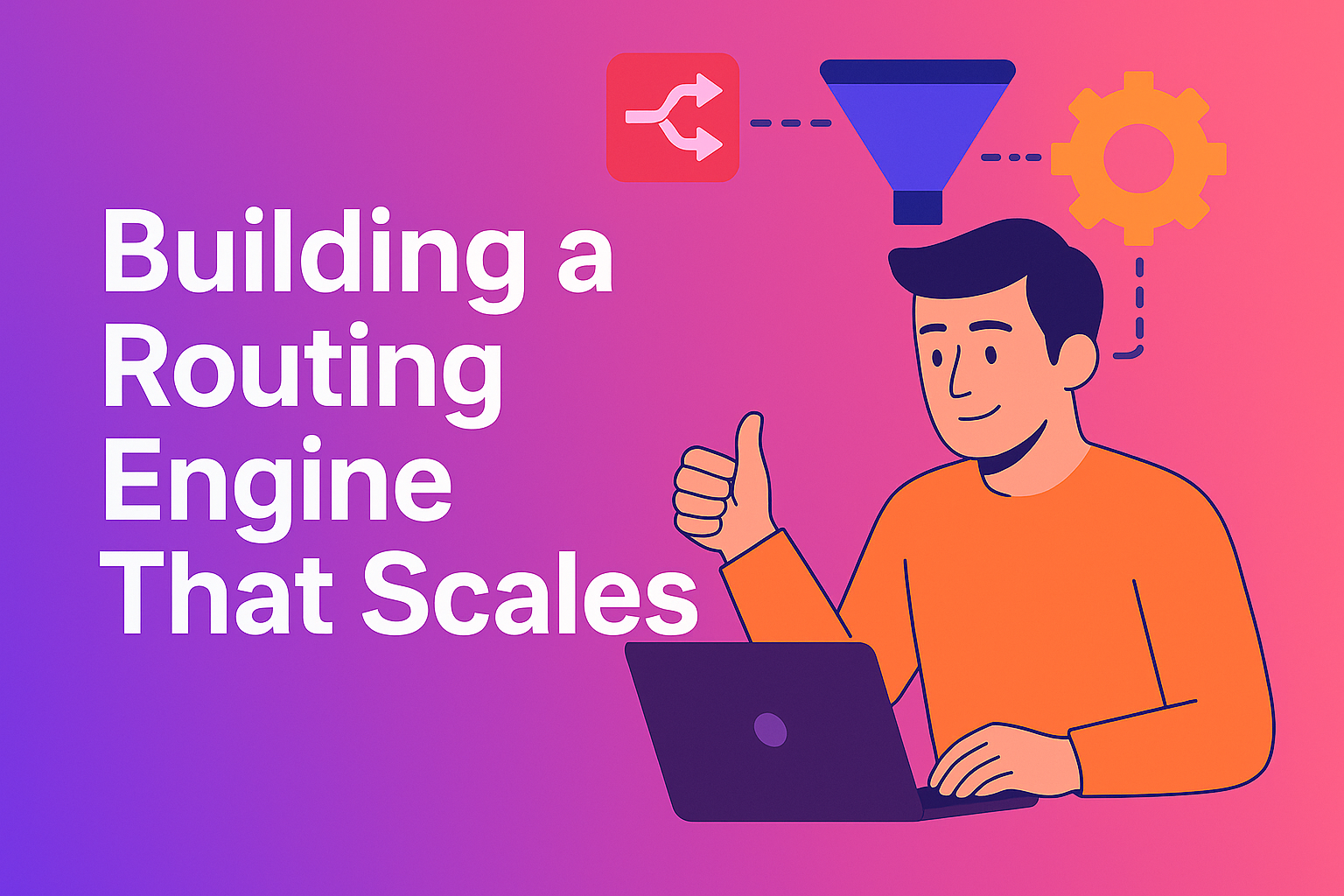In January, we wrote about the invisible roadblocks slowing down RevOps teams in 2025, slow response times, complex routing, and messy data. That piece came from hundreds of calls with teams who were tired of losing good leads between “Submit” and “Meeting booked”.
Since then, a lot has changed in RevenueHero.
Balanced Round Robin made meeting distribution actually fair. Inbound Links turned your routing logic into a single smart link usable anywhere. Native Enrichment and Routing Logs started to cut out guesswork and manual work from your funnel.
By mid-year, customers were already seeing faster speed-to-lead and higher form-to-meeting conversion. Clay, for one, moved from booking meetings with ~40% of qualified inbounds to 75%+.
So in H2 2025, we focused on the next set of problems operators in revenue teams kept bringing up on calls:
So let’s take a look at what we shipped in H2 2025 so you can scale campaigns, reps, and channels without losing control.
Cleaner pipeline in, less junk to clean up
A lot of teams came to us with the same story:
You run performance campaigns. Bots, disposable emails, and “test” submissions flood your forms. In security or fintech, you even get regular hacker traffic hitting “Book a demo”. Someone in ops spends hours every week bad‑data’ing and deleting junk. And even after that, you still worry about Gmail signups and unqualified leads slipping through.
H2 2025 was about giving you more control at the gate.
Real-Time Spam Defense: let good leads through, stop the rest
In July, we shipped Real-Time Spam Defense. RevenueHero now talks to ZeroBounce natively and validates every form submission in real time.
You can define clear rules:
If the email is spammy, temporary, or fails validation, silently block the calendar, send them to a different page. Use the DQ property instantly synced to your CRM to enrol them to a nurture queue.
If it looks valid, route as usual through your rules and queues.
The result: fewer junk meetings on rep calendars, fewer junk records in your CRM, and far less manual cleanup.
For teams in high‑risk spaces (security, fintech, crypto), this has been especially important. You’ll hear often from RevOps leaders that in “the hacking world” you often see repeat offenders submit forms. Now they can track bad domains and block them, while still keeping a log of the attempts for analysis.
Smarter handling of personal and generic emails.
Many of you don’t want to outright block Gmail or Outlook, but you also don’t want every free email address landing with your AEs.
With the latest routing controls, you can:
So you still keep more data than not, just without wasting AE time on obvious junk.
More enrichment options for higher-quality meetings
In May, we introduced Native Auto-Enrichment: RevenueHero enriches a lead the millisecond the form submits, then routes based on enriched fields, all without adding extra fields to your form.
And unlike what you get with legacy schedulers, enrichment for both people and accounts.
In October, we expanded that story:
You can now enrich inbound demo requests with ZoomInfo and Ocean, bringing the total to five enrichment providers you can mix and match.
You can set up multi-provider “waterfalls” for better coverage. For instance - Clearbit first, then ZoomInfo, then Crustdata if the first two miss, and Apollo as a fallback.
Teams that used to wait 30+ minutes for HubSpot workflows and enrichment to catch up before routing now decide in seconds who should see a calendar and who should be disqualified or nurtured.
Better booking experiences
In July, we introduced Layouts. A way to centralize how every RevenueHero-powered scheduler looks and feels.
Instead of each team or campaign hacking together its own styling:
You design your booking layout once (logos, brand colors, fonts, copy). Any time your sales team shares a personal meeting link to book a meeting for their follow ups with their deals, it presents the same, consistent delightful brand experience your marketing team worked hard to maintain.
All this without chasing a single sales rep ever. Ops and marketing control the experience centrally, so you don’t wake up to rogue on-brand-ish experiments in the wild.
This has been especially useful for teams with a large number of sales reps and long sales cycles.
Custom Form Fields: more context, not more friction
August’s release tackled a tricky tradeoff: when leads book from a LinkedIn ad, nurture email, or cold outreach, you often know something about them, but you may still be missing key data to route and prep the meeting.
Previously, your options were:
Redirect them to a long marketing form and risk losing them. Let them book immediately with little context, and risk a bad first call. Custom Form Fields inside RevenueHero scheduling flows give you a third option.
Now you can:
This matters when:
- Your routing depends on fields that might not always be available/discoverable automatically and needs an SDR to collect before the handoff.
- You have many lead sources (G2, Capterra, partners, website, in‑app) and want a consistent handoff to sales, regardless of where they came from.
Routing Logs and saved views - less detective work, more answers
If you work in RevOps, you’ve probably heard some version of:
Before Routing Logs, answering those questions often meant digging through:
⚠️ CRM history ⚠️ Form submissions ⚠️ Calendar events.
Or wrangling with support if your workflows were built on tools like Chili Piper, or Calendly.
Routing Logs was one of the earliest features RevenueHero launched with. An audit trail for every routed meeting. For each form submit or booking link click, RevenueHero records: trigger source, matching rule evaluation, fallback pods, scheduler render, final assignee, and downstream writes to CRM and calendar.
In H2, we made Routing Logs much easier to live in day to day.
Views for Routing Logs: save your favourite investigations.
By October, many customers were using Routing Logs daily almost like a “CSI replay” for inbound. We noticed people applying the same filters again and again:
So we shipped reusable views for Routing Logs.
Now you can:
Meeting link export: clean up the routing clutter
As your team grows, so does the number of meeting links floating around: old personal links, from people who left the company, the ones that were set up just out of curiosity and the ones that should never see the life of the day, with all those outdated videos and brand images.
In October, we introduced Meeting Link Export:
Scale your team without losing control
Another pattern we heard on calls:
“What matters to me is how quickly my team can go live with the campaign… We can’t have a situation where the tech stack is hampering us.”
You’re growing headcount, adding regions, and spinning up new campaigns. The last thing you want is ops time lost to:
- Chasing expired Zoom integrations.
- Debugging why a specific rep isn’t getting meetings.
- Trying to reconcile the final count of users.
Revamped User Management: the control tower for admins
In October, we rolled out a new User Management experience.
From one view, admins can now:
See all users and quickly spot where something is off - mismatched emails between RevenueHero and the CRM, expired conferencing integrations, or missing calendar permissions. Filter down to “users who need attention” instead of clicking through profiles one by one. Fix issues before they result in missed meetings or routing failures.
This sounds small, but it matters a lot when:
- You double your AE team in a year.
- You run many campaigns and can’t afford broken calendars.
- You’re trying to keep speed-to-lead low without constantly involving engineering.
It reflects why teams like Clay value RevenueHero: it lets ops move faster without asking devs to patch routing rules every time. A big part of scaling is trusting that when something does go wrong, it will get addressed fast. RevenueHero delivers reliability and support that matches your pace.
Another theme of love from our customers is the responsive Slack support that all our customers receive. Fast resolution times, and the ability to implement complex routing without long IT projects.
All the H2 work on user management, logs, and exports is meant to match that expectation: fewer surprises, faster fixes, and less need to even drop a slack message in the first place.
Meeting orchestration that fits real GTM complexity
Most teams we speak with don’t have a simple “website to SDR to AE” motion anymore. They have:
And they want one simple promise: whoever raises their hand should get to the right rep, fast.
Earlier this year, features like Balanced Round Robin and Collective Round Robin (with Pairings) addressed fairness and multi‑rep meetings. H2 features build on that base so you can bring more sources and edge cases into the same orchestration layer:
- Spam Defense and email rules keep out junk while still capturing legitimate long-tail interest.
- Custom Form Fields give you just enough extra context to route and prep for meetings from ads, nurtures, and cold outreach.
- Multi-provider enrichment lets you run smart waterfalls so you’re not tied to a single data vendor.
- Views for Routing Logs and User Management make it realistic to operate all this complexity across large teams.
As Osman at Clay summed it up:
That’s what this orchestration is for. Less tools‑juggling, more prospects talking to the right person on day zero.
What this means for RevOps in 2025 (and beyond)
Looking back at H2 2025, a pattern emerges.
We set out to focus on the seemingly boring things that make or break revenue at scale:
- The spam lead your AE wastes time on.
- The long form that scares away a good prospect.
- The mystery routing rule that sends an enterprise deal to the wrong queue.
- The expired integration that quietly stops meetings from getting booked.
Each H2 release:
Spam Defense, Layouts, Custom Form Fields, Routing Log views, Meeting Link Export, expanded enrichment, and revamped User Management came directly from conversations with operators trying to fix these exact issues in their own stacks.
And it’s working. Teams are booking more of their qualified inbounds on the same day, instead of days later. They’re running more campaigns without asking, “Will our routing keep up?”
They’re spending less time being “routing detectives” and more time building the next motion.
We’ll keep listening, and we’ll keep shipping the small guardrails that remove invisible roadblocks.
If you’re running into new ones whether it’s a weird custom object setup, multi‑calendar constraints, or new inbound sources bring them to us. The fastest way to see where H2 2025 can help in your stack is to run through your actual funnel together and see where the friction still lives.
Let RevenueHero help your team turn high-intent users into booked meeting without slowing down your funnel.






 Product signups.
Product signups.
 Partner referrals.
Partner referrals.
 G2/Capterra leads.
G2/Capterra leads.
 In-app upgrade requests.
In-app upgrade requests.
 Events and webinars.
Events and webinars.










